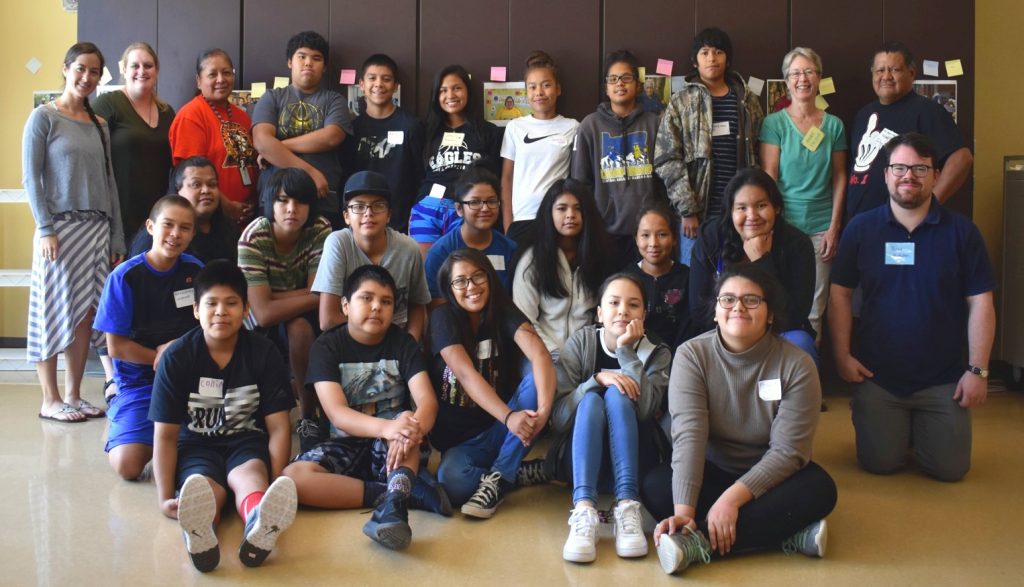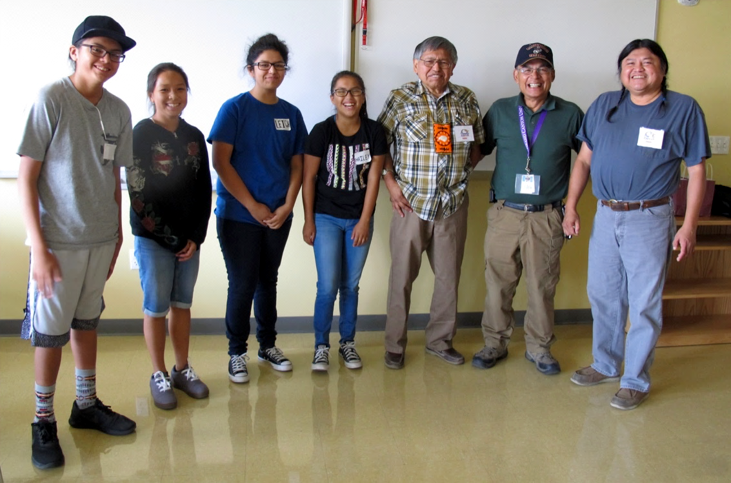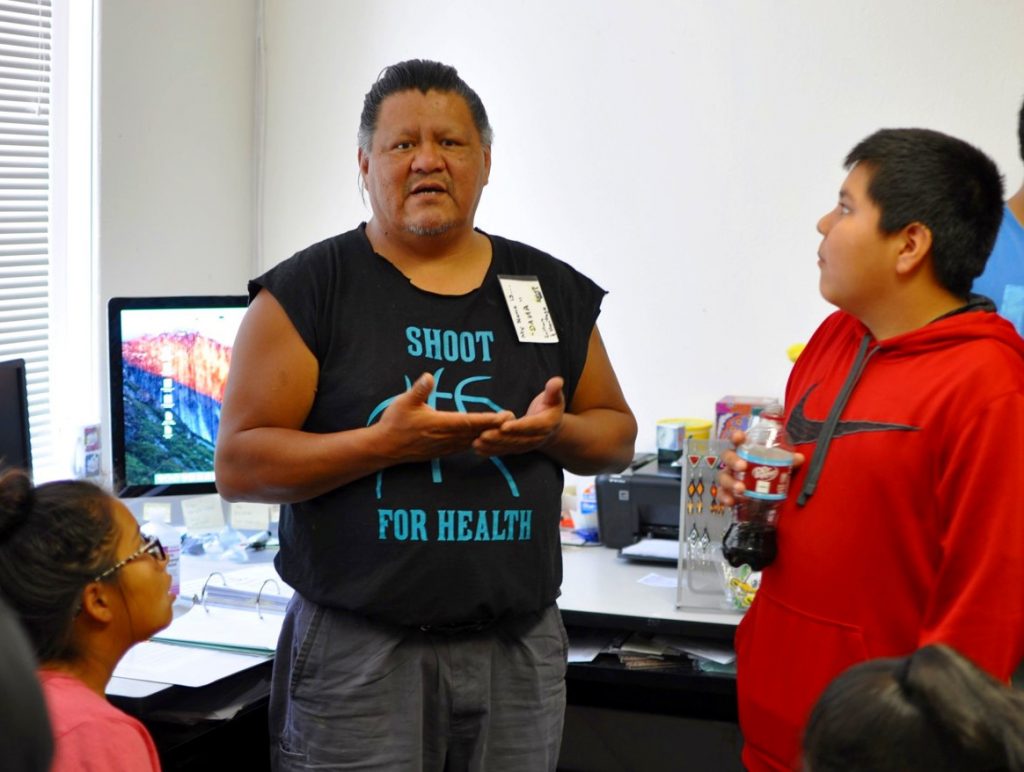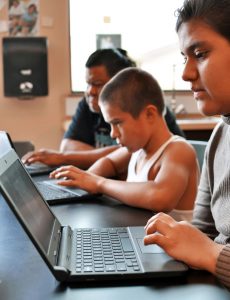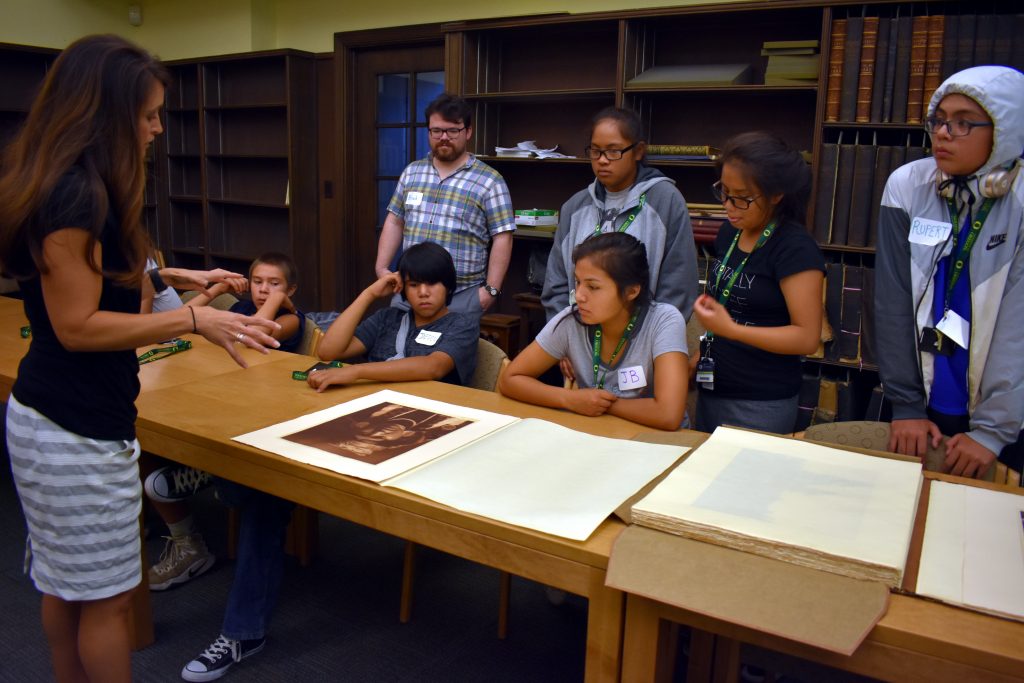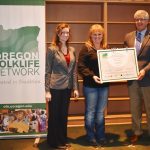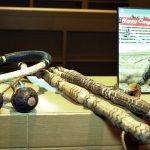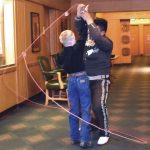Check out traditional Polynesian dancer Novelyn Tavita on the Oregon Culture Keepers Roster.
Monthly Archives: November 2017
Media Corner – Jayanthi Raman
Watch TAAP Master Artist Jayanthi Raman (2015) and her apprentice Bakul Godbole demonstrate Bharatha Natyam Indian Dance.
Traditional artist Esther Stutzman receives 2017 Governor’s Art Award
Alina Mansfield

(left to right), Oregon Arts Commission Chair, Christopher Acebo; Esther Stutzman; Governor Kate Brown (photo, courtesy of the Oregon Arts Commission, ©2017)
OFN is pleased to announce that Traditional Arts Apprenticeship Program (2013) master artist Esther Stutzman received a prestigious 2017 Lifetime Achievement Governor’s Art Award for her work in Oregon as a traditional Kalapuya/Coos storyteller. OFN nominated her for the 2017 Governor’s Art Awards, Oregon’s highest honor for exemplary service to the arts, which Gov. Brown revitalized after a 10-year hiatus. Ms. Stutzman was recognized during a ceremony that preceded the 2017 Oregon Arts Summit on Oct. 6, in Portland.
In addition to being a 2012 Oregon Folklife Network TAAP awardee, Esther Stutzman (Kalapuya/Coos) is the primary storyteller for Mother Earth’s Children, an American Indian theatre group that has performed for school assemblies and a variety of events and conferences for the past 42 years. Stutzman also works with Title VII Indian Education programs and Arts in Education Programs throughout the state of Oregon as a cultural resource specialist with children as well as with teacher in-service programs. She has been a long-time presenter for the Oregon Chautauqua History Series and is a recipient of several folklife awards formerly administered by the Oregon Historical Society. She recently shared her Tribes’ Mother Wolf and Coyote stories at the Museum of Natural and Cultural History in Eugene for their Wolf Talks celebration.
2017 Warm Springs Folklife Field School Highlights
Jennie Flinspach and Brad McMullen
The 2017 Warm Springs Folklife Field School engaged rising eighth graders from the Confederated Tribes of Warm Springs K-8 Academy in a week-long adventure to explore their heritage and document their cultural traditions.
Students learned fieldwork skills by interviewing each other. Using OFN’s recording equipment, students questioned each other about treasured family objects.
Students worked in groups to conduct interviews with tribal elders. We were honored to hear the elders’ share moving accounts of their heritage and traditions.
On Wednesday, students and staff took a field trip to the Warm Springs Culture and Heritage Department. Tribal archivist, Creston (Dana) Smith, one of our on-site teachers, showed us how he preserves the recorded history and culture of Confederated Tribes of Warm Springs.
After their interviews, students learned to process and analyze audio clips from their audio recordings. They wrote reflections, recorded narration, and assembled clips into a group presentation.
One of the special highlights of the week was Thursday’s visit to the Warm Springs radio station, KWSO 91.9 FM, where Marge Kalama, local radio personality, conducted a live on-air interview with the students.
At the end of the week, the students presented their research to the Warm Springs community. It was the perfect way to end a great week of cultural documentation! But there was still more in store for these young folklorists…
Two weeks later, the students traveled to the University of Oregon for an overnight campus visit. They visited Special Collections, where Corrigan Solari University Historian and Archivist Jennifer O’Neal showed them the Edward Curtis photographic collection, an invaluable collection of late 19th-century Native American portraits and images of traditional occupations and lifeways.
At the Jordan Schnitzer Museum of Art, Curator Cheryl Hartup gave a tour of “Conversations in the Round House: Roots, Roads, and Remembrances,” an exhibit of native works including one from Warm Springs elder, Lillian Pitt.
A stop at the Museum of Natural and Cultural History included a tour of the new Cultural Wing, which includes exhibits and short documentaries about Oregon’s native Tribes, past and present.
Our guests enjoyed a backstage tour of Matthew Knight Arena, where they got to “throw their O” at center court. Capping off the afternoon was a walk through Kalapuya Ilihi Hall, the newest residence hall on campus and home to the new Native American and Indigenous Studies academic residential community.
The next morning, Warm Springs students presented their research at the Many Nations Longhouse to UO Native students, faculty, and staff. At a special luncheon that followed, audience members reciprocated and shared with students the many opportunities and resources available to them as future UO Ducks.
Before heading back to Warm Springs, students had some fun with Professor Kirby Brown (English Department, Native literature), who taught them how to play sjima. Sjima, also known as Shinny Ball, is a traditional game with similarities to hockey and lacrosse and is specific to Oregon’s Klamath tribes.
TAAP Master Artists Recognized at Legislative Event
On Monday November 13th, state officials recognized Oregon’s 2016-2018 Traditional Arts Apprenticeship Program master artists at the State Library in Salem, Oregon.
The ceremony opened with words of welcome from MaryKay Dahlgreen (State Librarian), Riki Saltzman (Executive Director, Oregon Folklife Network), Brian Rogers (Executive Director, Oregon Arts Commission and Oregon Cultural Trust), and Beth Dehn, newly appointed Manager, Oregon Heritage Commission. Brian Rogers and state legislators, Representative Margaret Doherty (District 35), Representative Cliff Bentz (District 60), Representative Andrea Salinas (District 38), and Greg Mintz, Legislative Director for Senator Ken Helm (District 34), presented commemorative certificates to master artists (pictured R-L) Tonya Rosebrook, Hossein Salehi, Azar Salehi, Marjan Anvari, Jack Armstrong, Sara Siestreem, Anita Menon, and Feryal Abbasi-Ghnaim. Apprentice Miguel Ruiz and his son Miguel Jr. accepted the award on behalf of his mentor, Antonio Huerta. Representative Cliff Bentz and Brian Rogers presented a certificate to Roberta Kirk in absentia. The ceremony, which recognized the artistic excellence of these exemplary culture keepers, featured virtuosic performances by Azar Salehi (Persian storytelling) and Hossein Salehi (Persian santoor, a trapezoidal-shaped stringed instrument similar to the hammered dulcimer).
During a reception in their honor, TAAP master artists had the opportunity to interact with each other as well as elected officials, state government representatives, OFN staff, and members of the Oregon Arts Commission and Cultural Trust boards. Many brought examples of their works to share, demonstrate, and display their artistry. Charrería apprentice, Miguel Ruiz, treated everyone to an impromptu display of the roping skills required for Mexican rodeo.
Congratulations again to all of the 2016-18 TAAP master artists. We also extend our appreciation to all who were able to attend and honor those artists and their contributions to Oregon’s living cultural heritage.
- Riki Saltzman, Anita Menon, and Brian Rogers
- Riki Saltzman, Miguel Ruiz, Miguel Ruiz Jr. and Representative Margaret Doherty
- Emily West Hartlerode, Azar Salehi, and Brian Rogers
- Beth Dehn, newly appointed Manager, Oregon Heritage Commission
- OFN Program Coordinator Alina Mansfield and Graduate Student Assistant Brad McMullen
- Brian Rogers (Executive Director, Oregon Arts Commission and Oregon Cultural Trust)
- Hossein Salehi playing Persian santoor, a trapezoidal-shaped stringed instrument similar to the hammered dulcimer
- Hossein Salehi playing Persian santoor
- Riki Saltzman, Jack Armstrong, and Representative Margaret Doherty, District 35
- Emily West Hartlerode, Marjan Anvari, and Representative Andrea Salinas, District 38
- Emily West Hartlerode, Representative Cliff Bentz, District 60, and Brian Rogers present award to Roberta Kirk in absentia
- Riki Saltzman, Sara Siestreem, and Representative Margaret Doherty, District 35
- Emily West Hartlerode, Toyna Rosebrook, and Representative Cliff Bentz, District 10
- Emily West Hartlerode, Hossein Salehi, and Brian Rogers
- Riki Saltzman, Feryal Abbasi-Ghnaim and Representative Margaret Doherty, District 35
- Examples of artists’ work
- Examples of Jack Armstrong’s braided rawhide bosals and quirts.
- Examples of Feryal Abbasi-Ghnaim’s fine embroidery on miniature Palestinian dresses.
- At the reception
- Miguel Ruiz Jr. and his father, Miguel Ruiz
- Representative Margaret Doherty (District 35) and Jack Armstrong
- Representative Cliff Bentz (District 60) and Jack Armstrong
- Representative Cliff Bentz (District 60) and Tonya Rosebrook
- Representative Andrea Salinas (District 38) and Marjan Anvari
- Miguel Ruiz Jr. demonstrating charrería (roping) skills.
- Miguel Ruiz demonstrating charrería (roping) skills.
- Miguel Ruiz Jr. demonstrating charrería (roping) skills.

